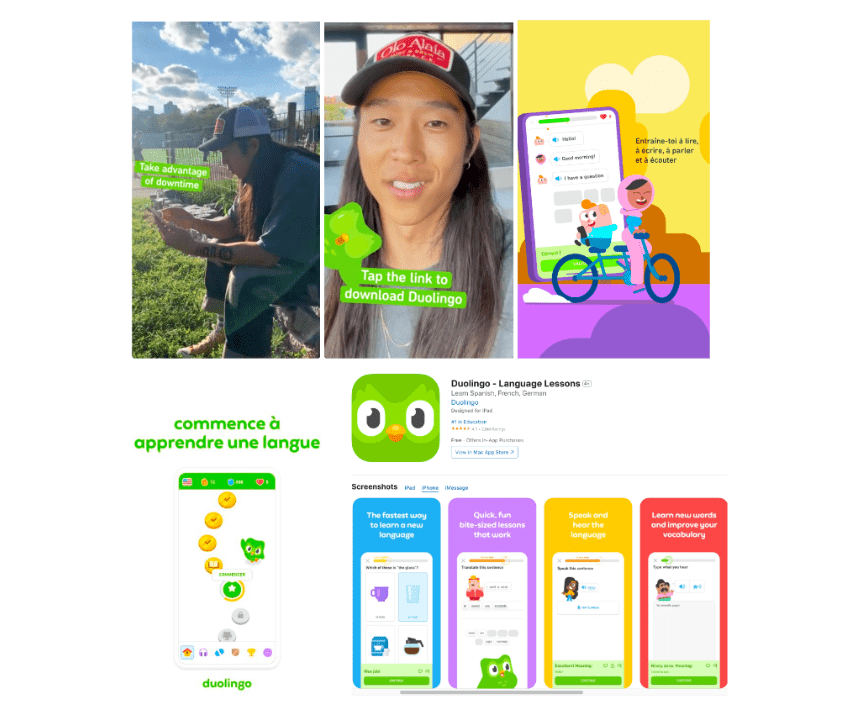With millions of apps vying for attention on various platforms, standing out becomes not just a goal but a necessity for your success. At the heart of this competition lies the challenge of developing creatives that resonate with users on a brand level while also driving tangible performance outcomes. This complex balance between branding and performance is crucial for any business. In this piece, I will explore the dynamics of branding and performance within app creatives, offering you some insights on how you can harmonize these elements to achieve both immediate and long-term success.
Table of Contents
Think branding and performance can’t coexist? Think again.
Branding in the context of your app creatives is about crafting a unique identity and consistent experience that reflects the core values and message of the business. It’s about making a memorable impression on your users; one that fosters recognition and loyalty. Performance, on the other hand, focuses rather on the measurable aspects of your app creatives—how they contribute to user engagement, conversion rates, and your overall business objectives.
The ultimate goal is to design creatives that not only captivate your users with their aesthetic and brand-aligned messaging, but also compel them to take desired actions, whether that’s making a purchase, signing up for a newsletter, or simply engaging more deeply with the app.
Balancing these two aspects requires that you have an understanding of both your brand’s identity and the target audience’s preferences and behaviors. I’ve always believed it needs a strategic blend of creative design, user experience optimization, and data-driven decision-making.
Brand bonds: Is your app creating connections?
The Essence of Branding
Branding is the heartbeat of any marketing strategy, extending far beyond visual elements like logos and color palettes to encompass the entire user experience within an app. It’s about communicating the essence of who you are as a business and what you stand for, creating a connection with users that goes beyond the superficial. In the realm of app creatives, branding encompasses several key components:
 Visual identity: This includes the use of colors, typography, imagery, and other visual elements that align with the brand’s overall identity. Consistency in visual identity across all touchpoints reinforces brand recognition and facilitates a seamless user experience.
Visual identity: This includes the use of colors, typography, imagery, and other visual elements that align with the brand’s overall identity. Consistency in visual identity across all touchpoints reinforces brand recognition and facilitates a seamless user experience.
 Tone of voice: The way your app communicates, from push notifications to in-app content, should reflect your brand’s personality. Whether it’s professional, friendly, quirky, or serious, maintaining a consistent tone of voice helps solidify your brand’s character in the minds of your users.
Tone of voice: The way your app communicates, from push notifications to in-app content, should reflect your brand’s personality. Whether it’s professional, friendly, quirky, or serious, maintaining a consistent tone of voice helps solidify your brand’s character in the minds of your users.
 User Experience (UX): Your overall design and navigability of your app play a significant role in branding. An intuitive, user-friendly UX design not only makes your app more enjoyable to use, but also reinforces your brand’s commitment to quality and customer satisfaction.
User Experience (UX): Your overall design and navigability of your app play a significant role in branding. An intuitive, user-friendly UX design not only makes your app more enjoyable to use, but also reinforces your brand’s commitment to quality and customer satisfaction.
Does your app’s brand truly stand out?
In a saturated market where global app downloads reached 257 billion (in 2023), a strong brand identity can be your app’s biggest differentiator.
It tells your users what to expect and why they should choose your app over others. Branding builds emotional connections, engenders trust, and can significantly impact user retention and loyalty.
“Branding is not just about attracting new users; it’s about conveying a brand identity that keeps them coming back.”
Deb Paladino – Creative Lead @ Admiral Media
Here’s the role of performance in your app creatives
While branding brings life into your app, giving it identity and emotional appeal, performance ensures that this identity translates into action.
In the context of app creatives, performance is quantifiable, driven by metrics that measure how effectively an app engages its users and prompts them to take desired actions. These metrics include, but are not limited to:
- Conversion rates: The percentage of app users who complete a specific action, such as making a purchase or signing up for a service, out of the total number of users who were prompted to do so.
- User engagement: Indicators such as time spent on your app, retention rates, and interaction levels with content and features.
- Click-Through Rates (CTR): The ratio of users who click on a specific link to the number of total users who view the page, email, or ad.
These and other KPIs (Key Performance Indicators) offer insights into the efficacy of app creatives, informing how well they resonate with users and drive them towards the business’s goals.
Analytics: The backbone of successful app creatives?
Achieving high performance in app creatives, requires a blend of strategic design and ongoing optimization. Some of the proven strategies we work with, include:
- A/B Testing: By comparing different versions of app creatives, you can determine which elements resonate most with your users, leading to higher engagement and conversion rates.
- User feedback: Analyzing your user feedback can give you unique and actual insights into your users’ preferences and pain points, enabling you to make improvements to the app’s design and functionality.
- Analytics: Leveraging data analytics tools to monitor your user behavior and performance metrics allows you to make data-driven decisions, ensuring that your app creatives are always optimized for maximum impact.
Strategies for you to balancing branding and berformance
Balancing the artistic and emotional aspects of branding with the analytical, results-driven focus of performance is a dynamic challenge.
Successful use of these elements requires a holistic approach that considers the user’s journey from first impression to loyal customer. Here are some strategies we use, to achieve this balance:
Finding the Middle Ground
- Integrated design: Develop app creatives that seamlessly incorporate branding elements with user-centric design principles. This means creating visually appealing interfaces that also prioritize usability and functionality.
- Personalization: Tailor your content and experiences to individual users based on their preferences and behaviors. Personalized experiences not only boost performance but also strengthen the brand’s relationship with its users.
- Dynamic creative optimization (DCO): Use technology to automatically adjust creative elements in real-time based on user data. DCO can optimize performance while ensuring that branding remains consistent and impactful.
Learning from Success Stories
Examining case studies of apps that have successfully married branding with performance can offer valuable insights. These examples highlight the importance of consistency across all touchpoints, the use of data to inform creative decisions, and the flexibility to adapt to user feedback and changing market dynamics.
For instance, Duolingo maintains a consistently strong brand identity across all platforms and in the creative aspects of every campaign goal.

Brands such as Tinder, with a strong brand presence, excel not only in highly brand-focused creative campaigns but also in those with a direct message that are performance-oriented.

Challenges in balancing Branding and Performance
Despite best efforts, businesses often encounter hurdles in achieving the perfect balance. Overemphasis on branding can lead to neglect of performance metrics, while a sole focus on performance may dilute the brand’s identity. Additionally, maintaining consistency across different platforms and adapting to rapid changes in technology and user expectations can complicate efforts.
Here’s how can you overcome these challenges
- Prioritize user experience: When designing, always have the end-user in mind, ensuring that both branding and performance enhancements contribute to a positive, seamless user experience.
- Data-Driven creativity: Use your analytics and unique user feedback as the foundation for creative decisions, ensuring that the branding efforts are aligned with what actually resonates with users.
- Cross-Functional teams: Encourage a strong collaboration between your designers, marketers, and data analysts to ensure that both branding and performance perspectives are represented in the creative process.
Future Trends in App Creatives
The interplay between branding and performance in app creatives will keep evolving as we look into the future. Technologies like Artificial Intelligence, AR, and VR offer a highway to immersive and interactive brand experiences.
These technologies not only have the potential to enhance performance through personalized and engaging user experiences but also to elevate branding to new heights, offering unprecedented ways to connect with users on an experiential level hitting right in the audience’s emotions and driving meaningful interactions and loyalty through innovative and user-centered creatives.
Businesses that stay ahead of these trends, experimenting with new technologies and approaches, will have a better opportunity to make a larger impact on their audience.
Conclusion
Balancing branding with performance in creatives is a delicate yet essential task if you are looking for a consistent collaboration between the creatives produced for your full funnel creative strategy.
Understanding the importance of both elements, integrating them, and staying on trends, is key for businesses to create app experiences that not only resonate with users but also drive tangible results.






